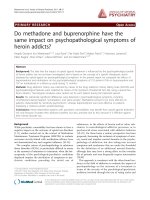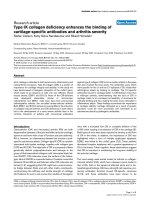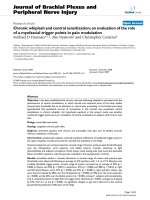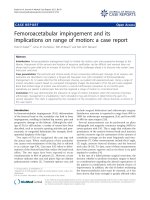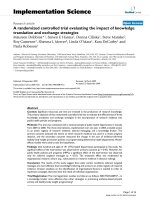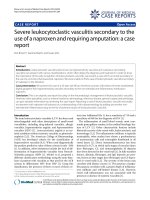Báo cáo y học: "Formulas Hypothermia and cardiac arrest: the promise of intra-arrest cooling" ppt
Bạn đang xem bản rút gọn của tài liệu. Xem và tải ngay bản đầy đủ của tài liệu tại đây (40.87 KB, 2 trang )
Page 1 of 2
(page number not for citation purposes)
Available online />Abstract
Over the past several years, the implementation of therapeutic
hypothermia has provided an exciting opportunity toward improving
survival from out-of-hospital cardiac arrest. There are compelling
data to support the prompt use of therapeutic hypothermia for
initial survivors from out-of-hospital cardiac arrest, but animal data
have suggested that initiation of therapeutic hypothermia during
the intra-arrest period may significantly improve outcomes even
further. In the first feasibility study in humans, Bruel and colleagues
report on the implementation of this intra-arrest approach among
patients suffering out-of-hospital cardiac arrest, an exciting pros-
pect that is discussed in the present commentary.
In the last issue of Critical Care, Bruel and colleagues report
findings from a small, prospective, observational study in
which they investigate the feasibility, efficacy and safety of
intra-arrest therapeutic hypothermia (TH) for victims of out-of-
hospital cardiac arrest (OHCA) [1]. From an initial pool of
412 cardiac arrest victims, the study enrolled 33 patients
with a variety of presenting rhythms. This represents the first
study of its kind to investigate the feasibility of intra-arrest
cooling in the clinical setting, an approach that has shown
significant promise in animal models of cardiac arrest and brain
injury [2-4].
Sudden cardiac arrest, defined as the abrupt loss of
mechanical cardiac activity and concomitant global loss of
blood flow, is a leading cause of death in the United States
and Europe. Approximately 200,000 people suffer OHCA in
the United States each year, and over 90% will succumb
during resuscitation efforts or during subsequent hospitali-
zation [5,6]. Survival to hospital discharge depends on a
number of factors, including prompt delivery of cardio-
pulmonary resuscitation and defibrillation when indicated, the
initial cardiac rhythm of arrest, and the quality of post-
resuscitation care including provision of TH.
Despite the significant effort that has been invested in this
field, few therapeutic or pharmacologic interventions have
yielded meaningful increases in overall survival from OHCA
over the past 20 years [6,7]. The relatively new and evolving
treatment modality of TH, however, has been associated with
markedly decreased mortality and neurologic injury among
patients who initially survive OHCA [8,9].
TH reduces both the cerebral metabolic rate and oxygen
demand, and it is thought to attenuate reperfusion injury,
global inflammation and endothelial dysfunction – all conse-
quences of cerebral and other organ ischemia [10,11].
Through such mechanisms, TH is thought to improve clinical
parameters and outcomes. Two landmark multicenter
randomized controlled trials of TH demonstrated over 20%
absolute mortality reduction for initial survivors of ventricular
fibrillation/ventricular tachycardia OHCA [8,9]. Although both
investigations documented strikingly improved survival in
patients who had TH implemented after blood flow was
restored, provocative animal data suggest that initiation of
cooling during cardiac arrest itself may yield further con-
siderable improvements in survival and neurologic outcome
when compared with the current standard of delayed TH. The
feasibility of such an approach in humans remains an active
question with a paucity of data.
The study by Bruel and colleagues examines the feasibility of
conducting intra-arrest cooling in the prehospital setting [1].
Although other investigators have evaluated prehospital imple-
mentation of post-resuscitation hypothermia [12,13], the
current study represents the first implementation of this novel
therapeutic approach in humans during the intra-arrest period.
The current work establishes that TH induction during the
intra-arrest period, using chilled medical saline during
Commentary
Hypothermia and cardiac arrest: the promise of intra-arrest
cooling
Roger A Band
1,2
and Benjamin S Abella
1,2
1
Department of Emergency Medicine, University of Pennsylvania, 3400 Spruce Street, Ground Ravdin, Philadelphia PA 19104, USA
2
Center for Resuscitation Science, University of Pennsylvania, 3400 Spruce Street, Ground Ravdin, Philadelphia PA 19104, USA
Corresponding author: Benjamin S Abella,
Published: 22 April 2008 Critical Care 2008, 12:138 (doi:10.1186/cc6845)
This article is online at />© 2008 BioMed Central Ltd
See related research by Bruel et al., />OHCA = out-of-hospital cardiac arrest; TH = therapeutic hypothermia.
Page 2 of 2
(page number not for citation purposes)
Critical Care Vol 12 No 2 Band and Abella
advanced life support prehospital care, was feasible and
without overt safety concerns. The technical and training
hurdles in conducting such an investigation are formidable,
and the authors should be applauded for their efforts. This
study lays the foundation for future work on a larger scale that
might incorporate randomization of patients to intra-arrest
hypothermia, post-resuscitation hypothermia or normothermic
resuscitation.
Furthermore, Bruel and colleagues’ study demonstrates the
feasibility of initiating intra-arrest hypothermia despite the
significant, inherent challenges of the prehospital environ-
ment. The authors accomplished cooling with only peripheral
venous access, although this may be technically more difficult
during absence of flow (or limited flow during cardio-
pulmonary resuscitation), and may be very dependent on the
quality of cardiopulmonary resuscitation and induced blood
flow.
Finally, the study suggests that intra-arrest cooling in the
prehospital environment may not only be feasible but also
efficacious [1]. More specifically, the time to reach mild
hypothermia (34ºC) was an impressive 16 minutes, sub-
stantially faster than other studies of post-resuscitation TH.
Although the sample size was small and the patient
population was varied, 20/33 (60.6%) of patients who were
successfully cooled had circulation restored, a trend that
suggests utility of cooling in the intra-arrest period. Despite
successes in early cooling, there were surprisingly modest
temperature differences at the time the patients were
admitted to the intensive care setting. This should not be an
insurmountable problem in future studies, and adjuncts to
intravenous cooling could easily be used to maintain the
hypothermic state.
One advantage of the European system that employed this
protocol was the presence of an Emergency Medical
Services physician and the ability to host the requisite
refrigeration unit and associated equipment. This calls into
question the ability to generalize this process to Emergency
Medical Services systems without these resources, although
it is likely that the tasks could be accomplished by skilled
prehospital personnel without direct physician oversight.
Finally, it is difficult to draw definitive conclusions about
safety from this fairly limited study population. The overall
number of enrolled patients was too small to detect
differences in the appreciably rare complications, and it is not
entirely clear over what time period the authors monitored for
complications and what objective criteria were used to
diagnose any observed adverse effects.
In summary, Bruel and colleagues’ innovative study is the first
to implement the use of TH prior to resuscitation from OHCA.
The authors demonstrate that prehospital, intra-arrest cooling
is possible and may be efficacious. This notion is supported
by our growing understanding of the pathophysiology of the
ensuing injury associated with low or no-flow states.
Mechanistically, early cooling may reduce reperfusion-related
injury by attenuating the oxidant burst seen within minutes of
normothermic reperfusion or by the inhibition of reperfusion-
activated apoptotic pathways. Future studies should include
objective measurements of patient pathophysiology to
understand better the kinetics of injury and the beneficial
effects of TH.
Competing interests
The authors declare that they have no competing interests.
References
1. Bruel C, Parienti J-J, Marie W, Arrot X, Daubin C, Du Cheyron D,
Massetti M, Charbonneau P: Mild hypothermia during advanced
life support: a preliminary study in out-of-hospital cardiac
arrest. Critical Care 2008, 12:R31.
2. Zhao D, Abella BS, Beiser DG, Alvarado JP, Wang H, Hamann KJ,
Vanden Hoek TL, Becker LB: Intra-arrest cooling improves out-
comes in a murine cardiac arrest model. Circulation 2004,
109:2786-2791.
3. Kuboyama K, Safar P, Radovsky A, Tisherman SA, Stezoski SW,
Alexander H: Delay in cooling negates the beneficial effect of
mild resuscitative cerebral hypothermia after cardiac arrest in
dogs: a prospective, randomized study. Crit Care Med 1993,
21:1348-1358.
4. Markgraf CG, Clifton GL, Moody MR: Treatment window for
hypothermia in brain injury. J Neurosurg 2001, 95:979-983.
5. Thom T, Haase N, Rosamond W, Howard VJ, Rumsfeld J, Manolio
T, Zheng ZJ, Flegal K, O'Donnell C, Kittner S, Lloyd-Jones D, Goff
DC Jr, Hong Y, Adams R, Friday G, Furie K, Gorelick P, Kissela B,
Marler J, Meigs J, Roger V, Sidney S, Sorlie P, Steinberger J,
Wasserthiel-Smoller S, Wilson M, Wolf P; American Heart Asso-
ciation Statistics Committee and Stroke Statistics Subcommittee:
Heart disease and stroke statistics – 2006 update. Circulation
2006, 113:85-151.
6. Eisenberg MS, Mengert TJ: Cardiac resuscitation. N Engl J Med
2001, 344:1304-1313.
7. Herlitz J, Bång A, Gunnarsson J, Engdahl J, Karlson BW, Lindqvist
J, Waagstein L: Factors associated with survival to hospital
discharge among patients hospitalised alive after out of hos-
pital cardiac arrest: change in outcome over 20 years in the
community of Goteborg, Sweden. Heart 2003, 89:25-30.
8. Bernard S, Buist M, Monteiro O, Smith K: Induced hypothermia
using large volume, ice-cold intravenous fluid in comatose
survivors of out-of-hospital cardiac arrest: a preliminary
report. Resuscitation 2003, 56:9-13.
9. Hypothermia after Cardiac Arrest Study Group: Mild therapeutic
hypothermia to improve the neurologic outcome after cardiac
arrest. N Engl J Med 2002, 346:549-556.
10. Safar P, Xiao F, Radovsky A, Tanigawa K, Ebmeyer U, Bircher N,
Alexander H, Stezoski SW: Improved cerebral resuscitation
from cardiac arrest in dogs with mild hypothermia plus blood
flow promotion. Stroke 1996, 27:105-113.
11. Hoesch RE, Koenig MA, Geocadin RG: Coma after global
ischemic brain injury: pathophysiology and emerging thera-
pies. Crit Care Clin 2008, 24:25-44.
12. Kim F, Olsufka M, Longstreth WT Jr, Maynard C, Carlbom D,
Deem S, Kudenchuk P, Copass MK, Cobb LA: Pilot randomized
clinical trial of prehospital induction of mild hypothermia in
out-of-hospital cardiac arrest patients with a rapid infusion of
4 degrees C normal saline. Circulation 2007, 115:3064-3070.
13. Myers JB, Lewis R: Induced cooling by EMS (ICE). Year one in
Raleigh/Wake County. J Emerg Med Serv 2007, 32:S13-S15.

